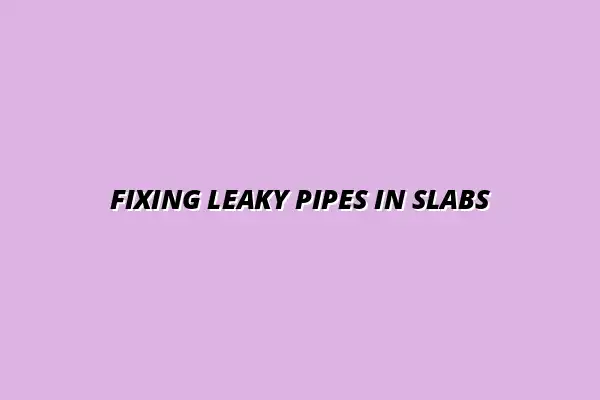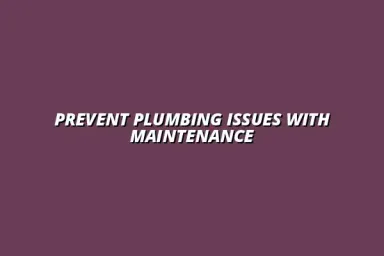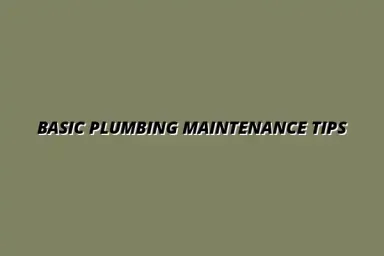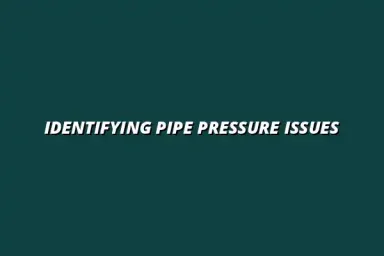Understanding Slab Foundations and Common Causes of Leaky Pipes
Slab foundations are a popular choice for homes, especially in warmer climates. They consist of a thick concrete slab that serves as the base of a building, providing stability and support. Understanding how these foundations work is key to recognizing issues, especially when it comes to plumbing problems like leaky pipes.
These foundations are typically placed directly on the ground and can help prevent moisture from seeping into the home. However, they are not immune to plumbing issues, which can lead to costly repairs. Knowing the structure and function of slab foundations allows homeowners to better maintain their properties and address potential problems early.
Defining Slab Foundations and Their Structure
A slab foundation is essentially a solid, flat piece of concrete that is poured directly onto the ground. This creates a stable base for the home, protecting it from elements like water and pests. The construction usually involves reinforcing the concrete with steel bars to enhance its strength.
The structure of a slab foundation includes several components, such as a base layer of gravel for drainage, a vapor barrier to keep moisture out, and the concrete slab itself. Homeowners should be aware that while slab foundations are less prone to settling than other types, they can still develop issues if not maintained properly. For example, leaks under the foundation are a common problem.
Characteristics of Slab Foundations
- Low profile, providing a stable base for homes.
- Generally more affordable than traditional foundations.
- Reduces risk of pest infestations.
- Offers energy efficiency due to thermal mass of concrete.
Despite their advantages, slab foundations can come with challenges. Homeowners should be vigilant about potential water leaks and soil movement, as these factors can significantly affect the integrity of the foundation and plumbing systems.
Benefits and Drawbacks of Slab Foundations
- Benefits: Quick installation, energy efficiency, and lower maintenance costs.
- Drawbacks: Difficulty in accessing plumbing systems for repairs and potential moisture issues.
Understanding these pros and cons helps homeowners make informed decisions when it comes to maintenance and repairs. It's essential to be proactive about potential leaks and regularly inspect the plumbing system, especially in homes with slab foundations. If you notice hidden pipe leaks, it's best to contact a professional.
Identifying Common Causes of Leaky Pipes in Slab Foundations
Leaky pipes in slab foundations can be caused by a variety of factors, and recognizing these can help prevent larger issues. It's essential to monitor your plumbing system and be aware of the conditions that can lead to leaks. Below are some common causes that homeowners should keep in mind.
Understanding how temperature fluctuations, soil conditions, and the age of plumbing systems can contribute to leaks is crucial. By identifying these factors, homeowners can take steps to mitigate the risk of leaks and protect their homes from water damage. For example, rusty pipes are a common culprit.
Effects of Temperature Changes on Plumbing Systems
Temperature changes can have a significant impact on the integrity of plumbing systems. When temperatures drop, pipes can contract, leading to cracks and leaks. Conversely, warmer temperatures can cause pipes to expand, which may result in stress and potential breakage.
- Cold temperatures can freeze water inside pipes, causing them to burst.
- Extreme heat can weaken pipe materials over time.
- Rapid temperature changes can lead to pipe fatigue.
Being aware of these effects allows homeowners to prepare for seasonal changes and take preventive measures to protect their pipes. Knowing how to fix a leaking bathroom pipe joint can save you money and time.
Impact of Soil Settlement and Shifting
Soil settlement and shifting can lead to serious plumbing issues, particularly for slab foundations. As the ground beneath the slab settles, it can create gaps or pressure points that may cause pipes to become misaligned or damaged. This can result in leaks that are difficult to detect.
To minimize the impact of soil issues, homeowners should consider:
- Regularly assessing the soil quality beneath the foundation.
- Improving drainage around the home to prevent soil erosion.
- Planting deep-rooted plants to stabilize the soil.
Understanding these factors can help homeowners maintain a stable foundation and reduce the risk of plumbing issues.
Wear and Tear on Pipes Over Time
Just like any part of your home, pipes can experience wear and tear over time. Constant use, pressure fluctuations, and the natural aging of materials can lead to deterioration, which increases the risk of leaks. Regular inspections can help spot these issues before they escalate. If you have problems with your kitchen sink, you might need to address a leak.
- Pipes made of older materials (like galvanized steel) may be more prone to corrosion.
- High water pressure can exacerbate the wear on pipes.
- Physical damage from construction or landscaping can create weak spots.
Being proactive about pipe maintenance can help you avoid costly repairs and ensure that your plumbing system remains in good condition for years to come.
Effective Methods for Repairing Leaky Pipes in a Slab Foundation
When faced with a leaky pipe in your slab foundation, you might wonder whether to tackle the job yourself or hire a professional. Each choice comes with its own set of benefits and challenges. Understanding these aspects can help you decide the best course of action for your situation.
For those considering a DIY approach, it’s essential to weigh the pros and cons. On one hand, DIY repairs can save money and offer a sense of accomplishment. On the other hand, you might lack the expertise and tools needed for a proper fix, which could lead to further issues down the line. If you're in Birmingham, you can find a plumber in Billesley.
Choosing Between DIY and Professional Repairs
Knowing when to call a professional versus when to fix it yourself can make all the difference. Here are some pros and cons of each option:
- DIY Pros: Cost savings, flexibility with time, and hands-on learning.
- DIY Cons: Potential for mistakes, lack of experience, and time-consuming.
- Professional Pros: Experience, warranty on work, and quicker completion.
- Professional Cons: Higher costs and scheduling constraints.
Understanding the costs associated with hiring a plumber can also guide your decision. Professional plumbing services can vary widely in price, depending on the complexity of the issue and your geographical location. For example, repairing a leaking water heater pipe can be complex.
Understanding Costs of Professional Plumbing Services
The cost of hiring a plumber for leaky pipe repairs can significantly affect your budget. Here are some factors that influence the overall price:
- Type of repair needed (e.g., patching vs. replacing)
- Location of the leak within the slab
- Emergency service fees if applicable
- Materials required for the repair
It's a good idea to get multiple quotes from different plumbers to ensure you’re making an informed decision.
Step-by-Step Guide for DIY Repairing Leaky Pipes
If you've opted for a DIY repair, having the right tools and materials is crucial for success. Here’s a quick list of what you’ll need:
- Pipe wrench
- Pipe cutter
- PVC or copper replacement pipes
- Adhesive sealant or epoxy
- Safety gear (gloves, goggles)
With the right equipment on hand, you can proceed to patch or replace the leaky pipes effectively. Be sure to follow the steps carefully to prevent future leaks!
Methods for Patching or Replacing Leaky Pipes
Here are some methods you can use for repairing leaky pipes in your slab foundation:
- Patching: Use epoxy or a pipe patching kit for small leaks. Clean the area before applying the patch.
- Replacing: Cut out the damaged section of the pipe and replace it with a new piece. Secure it with appropriate fittings.
- Using a sleeve: A pipe sleeve can be added over a small leak to provide a temporary fix until a permanent solution is made.
Whichever method you choose, make sure to turn off the water supply first to avoid any mess!
Innovative Solutions for Persistent Leak Issues
In cases where leaks keep occurring, you may need to consider more advanced solutions. Techniques like using epoxy putty or pipe relining can be game-changers!
Epoxy putty is a versatile and easy-to-use solution, perfect for quickly sealing leaks. It sets hard to create a waterproof seal, making it ideal for temporary repairs until a permanent fix is possible.
Considering Pipe Relining as a Long-Term Solution
Pipe relining is a more innovative approach for long-term leaks. This method involves creating a new pipe inside the old pipe, effectively sealing any leaks and preventing further issues. Here are some benefits of this solution:
- Less disruptive than traditional replacement
- Long-lasting results
- Can be used on various pipe materials
Investing in pipe relining can save you time and money in the long run!
Preventive Measures to Avoid Future Pipe Leaks in Slab Foundations
Taking proactive steps can help you avoid the headaches of leaky pipes in the future. Regular maintenance and inspections are key to keeping your plumbing system in good shape. By creating a home maintenance schedule, you can ensure that nothing is overlooked.
Regular Maintenance and Inspection Practices
Establishing a routine for checking your plumbing system is essential. Here's a list of practices to incorporate into your home maintenance schedule:
- Check for visible leaks under sinks and around appliances.
- Inspect exposed pipes for signs of wear or corrosion.
- Test your water pressure and adjust as necessary.
- Schedule annual plumbing check-ups with a professional.
Recognizing signs that indicate it’s time for a plumbing check-up can save you from bigger issues later. Look out for:
- Unusual spikes in your water bill
- Slow drains or recurring clogs
- Water stains on walls or ceilings
Understanding the Role of Waterproofing in Slab Foundations
Waterproofing is crucial for protecting your home from leaks and moisture. By investing in proper waterproofing solutions, you can minimize the risk of future leaks in your slab foundation.
Here are some common types of waterproofing solutions:
- Sealants: Used to cover cracks or joints in the foundation.
- Membranes: Applied to the exterior of the foundation for added protection.
- Drainage systems: Ensures that water is diverted away from the foundation.
Implementing these strategies can safeguard your home from water damage down the line!

 Kiran Almasi
Kiran Almasi

